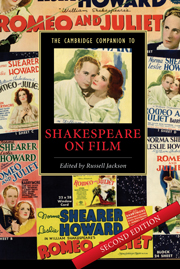Book contents
- Frontmatter
- Introduction: Shakespeare, films and the marketplace
- Part I Adaptation and its Contexts
- Part II Genres and Plays
- Part III Directors
- Part IV Critical Issues
- 14 Looking at Shakespeare’s women on film
- 15 National and racial stereotypes in Shakespeare films
- 16 Shakespeare the illusionist: filming the supernatural
- 17 Shakespeare’s cinematic offshoots
- Further Reading
- Filmography
- Index
- Series List
15 - National and racial stereotypes in Shakespeare films
from Part IV - Critical Issues
Published online by Cambridge University Press: 28 July 2007
- Frontmatter
- Introduction: Shakespeare, films and the marketplace
- Part I Adaptation and its Contexts
- Part II Genres and Plays
- Part III Directors
- Part IV Critical Issues
- 14 Looking at Shakespeare’s women on film
- 15 National and racial stereotypes in Shakespeare films
- 16 Shakespeare the illusionist: filming the supernatural
- 17 Shakespeare’s cinematic offshoots
- Further Reading
- Filmography
- Index
- Series List
Summary
We all object to stereotypes. They are oversimplified preconceptions, involving those who trade in them in lazy thinking and prejudice. They don't derive from direct experience. They are subject to fashion. And they tend to come into conflict with one another. But however objectionable they may be, on intellectual or moral grounds, we can't avoid them in our own, as well as other people's, thinking. When, in Kenneth Branagh’s film of Hamlet (1996), the Gravedigger (Billy Crystal) remarks that in England the men are as mad as Hamlet, we laugh. Not exactly uproariously, but in the way, no doubt, that the line has raised a laugh for four hundred years. We laugh at the complexity of the dramatic irony in the situation - the Gravedigger’s subject is his Prince, he is his Prince’s subject, and yet here he is literally addressing his Prince on the subject. However, we also laugh at the English playwright giving the Danish character a stereotypical characterisation of the English. And if we're English we laugh, slightly awkwardly, at the joke at our expense (not sure whether or not we recognise ourselves in it, not sure whether we're particularly proud of our great English playwright’s laboured handling of it). But when the actor saying the line is Billy Crystal, we laugh in a new way, too. Now the joke is not just a joke delivered by those traditional Shakespearean stereotypes the Common Man and the Clown, but a joke delivered by another set of stereotypes - the comic, the film star and the American. Even the nationality of the joke itself seems somehow to have changed a little. But what does 'nationality' mean? It is all very well objecting to national and racial stereotypes on the grounds that nations and races are maligned by their use. But what is it that is being maligned?
- Type
- Chapter
- Information
- The Cambridge Companion to Shakespeare on Film , pp. 267 - 279Publisher: Cambridge University PressPrint publication year: 2007

